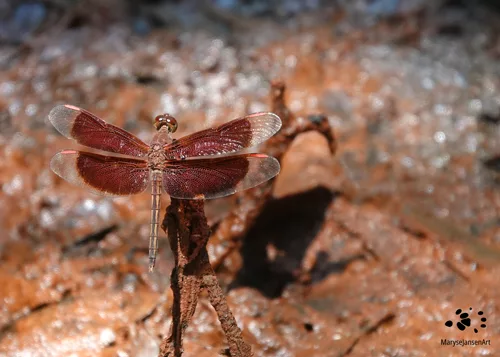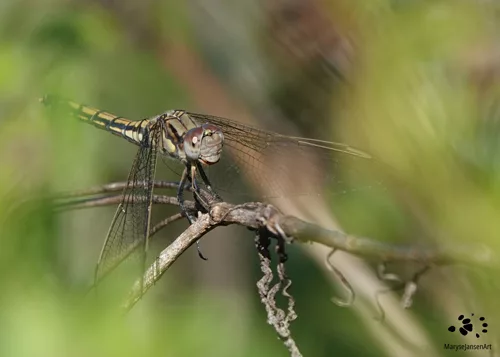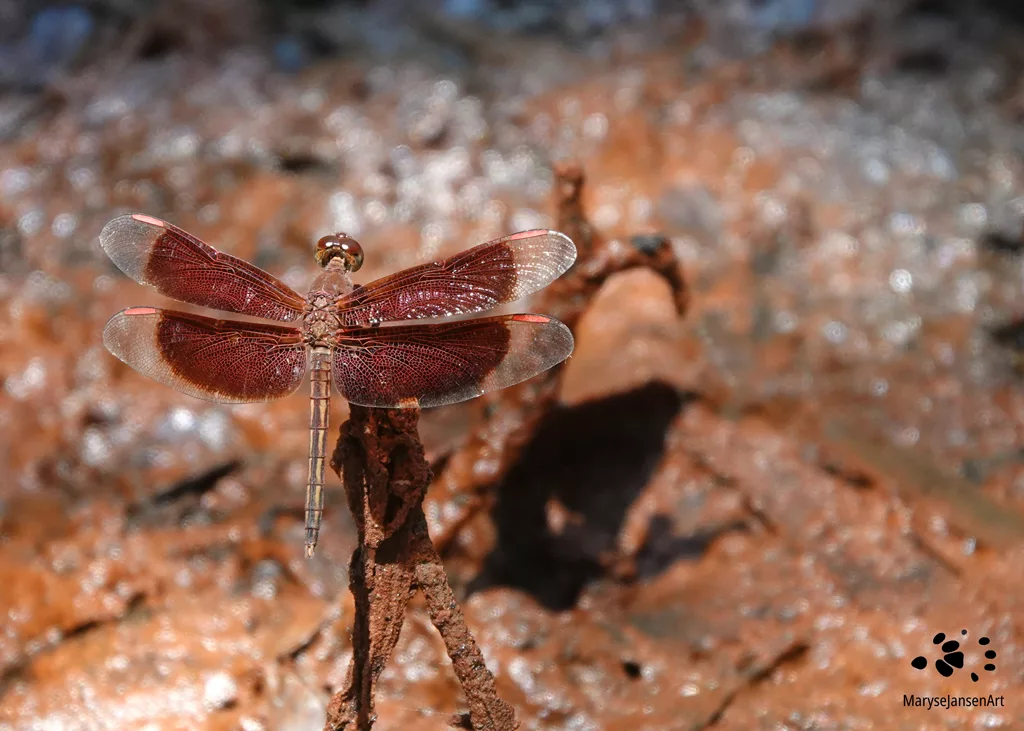Wildlife Photography with marysejansenart
Meet the Graphic Flutterer, the Blue Skimmer and the Sultan

Table of Contents
The Graphic Flutterer
It’s dragonfly season again! The weather is warming up and even in my garden the dragonflies are abundant at the moment, even though there is no fresh water source nearby! One species that is a regular visitor to my garden is particularly beautiful, due to the patterns on its wings. It is the Graphic Flutterer.
I spend some time photographing this species which is not so easy. They appear a bit camera shy so I can’t get anywhere near their perch or they’ll take off. Their flight is very unpredictable and they move on constantly to a new perch. Also, it is quite windy, so even as they are perched, I am dealing with movement. I manage a good shot though which you can see below.

Graphic Flutterers have golden-yellow wings with dark-brown patches. They hold their wings spread out while perched. The body is a metallic black and the eyes are a dark red-brown. The male and female look the same. Their flight is a bit weak, fluttering and gliding. They prefer a habitat of riverine lagoons, lakes, ponds and swamps, but can also be spotted in open areas far from water, such as my garden. They are widespread in most of Australia, except the south and the interior of New South Wales and Queensland.
Libellulidae
Like most of the dragonflies I have introduced to you so far during my walks in the Australian Bush, Graphic Flutterers belong to the family of Libellulidae. With more then 1000 species worldwide, this is the largest dragonfly family in the world! In Australia we find only 58 of these. This family includes Perchers, Skimmers, Flutterers and a number of lesser known genuses.
Libellulidae have in common that, compared to other dragonfly families, they have broader abdomen. Perhaps their relatively heavier body makes that they spend more time in rest then dragonflies in other families. The fact that they do that makes it a bit easier to photograph them. Taking photos of dragonflies in flight is notoriously difficult because of their high speed and erratic flight patterns. Many photographers will attest to that!
Unlike the Graphic Flutterer, a lot of dragonflies are sexually dimorph, which means that the male and the female look very different. There is commonly a difference in size, but most noticeably, a difference in colour. The males are usually bright in colour and easy to identify. The females however, are often duller in colour and, to make things more complicated, can vary greatly in colour within species.
The Blue Skimmer
I spot another dragonfly, it looks like a skimmer of some kind. A lot of skimmer species have bright blue or red coloured males. But this one has yellowish abdomen, with black stripes, greyish thorax, grey mandibles and the eyes are grey and brown. After lots of comparing of various images and descriptions in my guidebooks and on the internet, I decide it must be a female Blue Skimmer! Getting a good photo helps a lot when you try to identify a species! And I quite like the portrait that I took, it gives us a good look at her face!

Blue Skimmers are a medium sized dragonfly with a body length of 4.5cm and a wingspan of 7cm. They are widespread throughout Australia. Adult males have a light, powdery blue colouring and black eyes. Hence their alternative name of Sky Blue Dragonfly. Older males have a black tip on their tail. These dragonflies tend to fly close to the ground, perching on waterside plants and sticks. You may find them patrolling the water’s edge. Notice how she holds her wings below her body in rest. They inhabit a wide range of still as well as flowing waters.
The Sultan
I emerge from the rainforest, during one of my walks in the tropical north. There is a creek, lined with some mangroves and a narrow strip of marshland. Over a patch of muddy red dirt two dragonflies with gorgeous red-brown wings stop me in my tracks. Check out the featured image to see how beautiful it is! This dragonfly is known by the inspiring names of Sultan or Giant Knight! It is confined to the tropics. I am looking at males here. Females have a more golden-orange colour.
The Sultan can be found in lowland ponds and lakes in open areas, especially along the landward margins of mangroves – which is exactly where I am! They are quite large with a wingspan of about 10cm. It proves quite difficult to find more information about the species and apparently sightings are quite rare! So I am so pleased to be able to share my encounter with this stunning insect with you!
Not only did I get a good photo, I was also able to get some footage for my latest episode of ‘Come for a walk in the Australian Bush’! Check it out below:
If you are interested in purchasing ‘Sultan’ or would like to see what the image looks like on the various products, please head to my shop. If you prefer ‘Blue Skimmer Female’, click shop here, and for ‘Graphic Flutterer’, click shop here.
More images of dragonflies are showcased in my gallery of Australian Insects!


